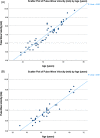Physical activity, physical fitness and cardiometabolic risk amongst adults with moderate and severe haemophilia
- PMID: 36195106
- PMCID: PMC10092720
- DOI: 10.1111/hae.14653
Physical activity, physical fitness and cardiometabolic risk amongst adults with moderate and severe haemophilia
Abstract
Aim: This study aimed to examine physical activity (PA), physical fitness and cardiometabolic risk amongst people with moderate and severe haemophilia (PwMSH).
Methods: The following domains were examined: PA (accelerometry); functional aerobic capacity (6-Minute Walk Test); grip strength (dynamometry); balance (One Leg Stand Test); body composition (anthropometry and bioimpedance analysis); blood pressure; arterial stiffness; and cardiometabolic disorders.
Results: A total of 53 PwMSH (44 years) and 33 controls (43 years; p = .679) were recruited. Compared to controls, PwMSH were significantly less active in moderate and vigorous PA parameters (all p < .05), and less physically fit indicated by 6-Minute Walk distance (p < .0005), grip strength (p = .040) and balance (p < .0005). PwMSH had higher rates of abdominal adiposity compared to controls measured by waist circumference indices (all p < .05). Resting blood pressure and arterial stiffness were not significantly different (p = .797 and .818, respectively). With respect to overall PA, World Health Organisation recommended targets for adults were achieved by the majority of both groups (haemophilia: 72.9% vs. controls: 90.0%; p = .069). Importantly, the number of PwMSH who achieved guideline recommended PA via longer, sustained bouts of moderate-vigorous PA was significantly lower compared to controls (18.8% vs. 56.7%; p = .001). Lastly, clinically diagnosed hypertension, insulin resistance and hyperlipidaemia were more prevalent amongst PwMSH compared to controls.
Conclusion: Low levels of PA and physical fitness, and significant rates of abdominal adiposity and hypertension may collectively influence the risk and severity of various cardiometabolic and/or musculoskeletal health issues amongst ageing PwMSH. Personalised multi-disciplinary health interventions involving PA, dietary and health psychology input for PwMSH warrant future investigation.
Keywords: cardiometabolic risk; fitness; haemophilia; hypertension; obesity; physical activity.
© 2022 The Authors. Haemophilia published by John Wiley & Sons Ltd.
Conflict of interest statement
Megan Kennedy has served on an advisory council to Takeda. Michelle Lavin has served on an advisory board to Tremeau Pharmaceuticals and as a consultant to Sobi. She received indirect funding from Takeda for the development of educational material. Niamh M. O'Connell has received research support from SOBI; participated in advisory boards for F. Hoffmann‐La Roche Ltd, UniQure, SOBI, Freeline; and participated in speakers’ bureaus for F. Hoffmann‐La Roche Ltd, SOBI and Novo Nordisk. James S. O'Donnell has served on the speaker's bureau for Baxter, Bayer, Novo Nordisk, Boehringer Ingelheim, Leo Pharma, Takeda and Octapharma. He has also served on the advisory boards of Baxter, Bayer, Octapharma CSL Behring, Daiichi Sankyo, Boehringer Ingelheim, Takeda and Pfizer. James S. O'Donnell has received research grant funding awards from Baxter, Bayer, Pfizer, Shire (now part of Takeda), Takeda and Novo Nordisk. Peter L. Turecek is full‐time employee of Baxalta Innovations GmbH, a member of the Takeda group of companies, and shareholder of Takeda Pharmaceutical Company Limited. The remaining authors have no competing interests to declare.
Figures
References
-
- Kempton CL, Makris M, Holme PA. Management of comorbidities in haemophilia. Haemophilia. 2021;27(suppl 3):37‐45. - PubMed
-
- Mauser‐Bunschoten EP, Fransen Van De Putte DE, Schutgens REG. Co‐morbidity in the ageing haemophilia patient: the down side of increased life expectancy. Haemophilia. 2009;15(4):853‐863. - PubMed
-
- Shapiro S, Makris M. Haemophilia and ageing. Br J Haematol. 2019;184(5):712‐720. - PubMed
-
- Harber MP, Kaminsky LA, Arena R, et al. Impact of cardiorespiratory fitness on all‐cause and disease‐specific mortality: advances since. Prog Cardiov Dis. 2009;60:11‐20. - PubMed
MeSH terms
Grants and funding
LinkOut - more resources
Full Text Sources
Medical



